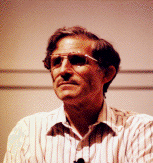
Invited Speaker
David H. Bailey
Researcher
NASA Ames Research Center
Moffett Field, CA
 |
Invited Speaker David H. Bailey Researcher NASA Ames Research Center Moffett Field, CA |
| Email: |
dbailey@nas.nasa.gov |
| Homepage: |
http://www.nas.nasa.gov |
| Contributions: |
Ramanujan, Modular Equations, and
Approximations to Pi or How to compute One
Billion Digits of Pi |
| Paper: |
Recognizing Numerical Constants |
| Talk: |
Recognizing Numerical Constants |
| Abstract: |
The advent of inexpensive, high-performance computers and new
efficient algorithms have made possible the automatic recognition of
numerically computed constants. In other words, techniques now exist
for determining, within certain limits, whether a computed real or
complex number can be written as a simple expression involving the
classical constants of mathematics.
In this presentation, some of the recently discovered techniques for
constant recognition, notably integer relation detection algorithms,
will be presented. As an application of these methods, the author's
recent work in recognizing "Euler sums" will be described in some
detail. The latter work was done jointly with Jonathan Borwein and
Roland Girgensohn of SFU/CECM.
|
| Born: |
Utah, USA |
| Education: |
B.S. in Mathematics from Brigham Young University (1972),
Ph.D. in Mathematics from Stanford University (1976).
|
| Family: |
I have a wife and four daughters, aged 9, 11, 14 and 16. My wife is
in biotechnology; she has been busy with child care for the past few
years but will soon return to full-time professional work. My eldest
daughter is an ambitious scholar who frightens her impoverished father
by using the "S" word (Stanford). The second eldest is a talented
athlete, competing in field hockey and soccer. The third may have
inherited some of her father's flair for mathematics, and the fourth
may have inherited some of his spunk. All are attractive, something
they most certainly did NOT inherit from their father...
|
| Interests: |
My research interests are somewhat schizophrenic, encompassing pure
mathematics (mostly computational number theory) on one hand, and
applied technology (high performance computing, including numerical
algorithms and parallel architectures) on the other. These two arenas
are almost completely disjoint -- colleagues in one are generally
unaware of my activities in the other.
|
| Comments: |
I want to do some great mathematical and scientific work, something
that will be remembered and cited long after I'm gone. But in
addition, I want to be an significant agent for the advancement of
technology and the betterment of society.
|